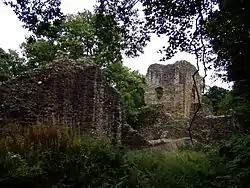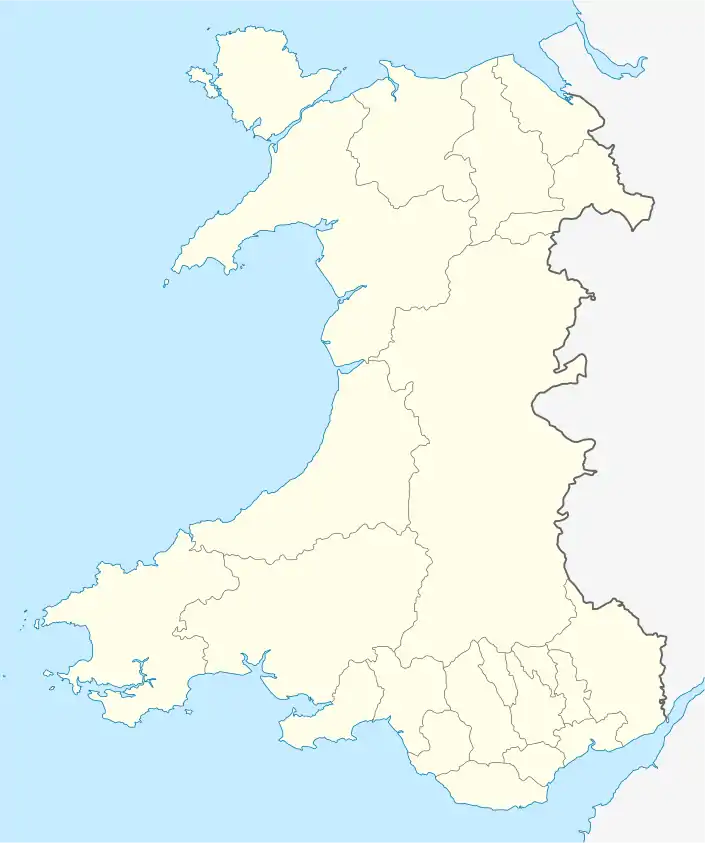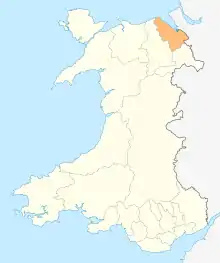Ewloe Castle
Ewloe Castle (Welsh: Castell Ewlo) is a native Welsh castle built by the Kingdom of Gwynedd near the town of Ewloe in Flintshire, Wales. The castle, which was one of the last fortifications to be built by the native Princes of Wales, was abandoned at the beginning of the invasion of Wales by Edward I in 1277. Its construction, using locally quarried sandstone, appears to have continued piecemeal over many years and may have not been completed. On taking the castle, the English Crown gave it little military value and allowed it to fall into ruin.
| Ewloe Castle | |
|---|---|
| Part of Flintshire | |
| Ewloe, Wales | |
 Part of Ewloe Castle's Welsh Keep and curtain wall | |
 Ewloe Castle | |
| Coordinates | 53.200°N 3.0670°W |
| Type | Motte-and-bailey, hillside castle |
| Height | 10 metres (33 ft) |
| Site information | |
| Owner | Cadw |
| Condition | Ruin |
| Site history | |
| Built | 12th–13th Century |
| Built by | Owain Gwynedd Llywelyn the Great Llywelyn ap Gruffudd |
| In use | Open to public |
| Materials | Sandstone |
Listed Building – Grade I | |
Ewloe was sited on high ground within Tegeingl, a cantref in the lands of North-east Wales (Welsh Perfeddwlad). Standing near the Chester road, it maintained a strategic position near the Wales–England border. The castle is located on a steeply-sloped promontory within a forested valley. It overlooks the junction of two streams with higher ground to the south.
Layout
Ewloe Castle combines features from both motte-and-bailey and enclosure castles. An asymmetrical curtain wall – with parapets – encloses two courtyards. A rock-cut neck ditch defends the southern side of the castle. In the upper triangular inner ward is a D-shaped tower known as the "Welsh keep". This stands on a stone outcrop that forms the motte; it has a stone revetment around its base (a basic Chemise). The lower outer ward is enclosed by two separate sections of wall that meet at a circular fortified tower, which stands upon a rocky knoll. As the curtain walls are not joined together, ladders would have had to be used to reach their parapets.
No gateways connected the inner ward to the outer courtyard. Access into Ewloe Castle was entirely via wooden ramps. The outer ward had several wooden buildings. An external defensive rampart occupies the higher ground to the south of the castle above the neck ditch.
Within the inner ward is a D-shaped (or horseshoe-shaped) tower known as the "Welsh Keep". Although a flight of stairs lead up to a first floor gateway – a similarity shared with contemporary military architecture, the shape of the tower does not conform with keeps of the later Plantagenet period. D-shaped towers usually projected out from a wall or gatehouse but at Ewloe the castle builders placed the tower/keep on a motte in the upper ward surrounded by its own curtain wall. This feature has precedence in Welsh military architecture. Llywelyn the Great built a similar D-shaped tower at Castell y Bere at Llanfihangel-y-pennant in Gwynedd in the 1220s.
The tower's outer walls – which are 2 m (6 ft 7 in) at their base – rose to about 11 m (36 ft). They were higher than the upper storey to protect its pitched roof from projectiles. A parapet ran around the top of the tower. Spaces in the stonework show where storage slots were placed in the upper roof spaces. The tower had a single first floor hall that stood above a lower ground floor chamber. Defensive arrowslits were placed on the curved sides of the tower. The flat side, which overlooks the outer ward, has a Romanesque window.
History
Background
Formerly thought to have been built around 1257 by Llywelyn ap Gruffudd, it is now thought that Ewloe was built by Llywelyn's grandfather, Llywelyn ab Iorwerth. Various periods have been put forward for its construction, including the period 1221-37, and 1213-18. It is believed that the castle was erected in its position in Ewloe wood in order to commemorate the victory of Owain Gwynedd, prince of Wales in the Battle of Ewloe against the forces of Henry II in 1157. If construction commenced in the 1210s, Ewloe may have been a factor in prompting the earl of Chester to normalise relations with Llywelyn. After 1218, the two men remained allies until the earl's death in 1237.[1]
1241-60: Abandonment and refurbishment
During protracted legal disputes over control of the lordship of Mold in the early 1240s, Ewloe was used as a base for negotiations between Llywelyn's son, Dafydd ap Llywelyn, and the officials of Henry III of England. After the Welsh defeat in the war of 1244-46, Ewloe appears to have been abandoned, and English authority was established over the north-east.
Ewloe was recaptured by the forces of Llywelyn ap Gruffudd during his reconquest of the Perfeddwlad in 1256-57, and was refurbished by him in the latter year. It again provided the backdrop for negotiations between the Welsh and the English in 1259 and 1260.[2]
Demise
In 1276, Edward I began the first Welsh War by marching his forces out of the castle at Chester and up the west coast of the Dee Estuary. After an advanced base was established at Flint (a day's travel from Chester), building work immediately began on Flint Castle. Ewloe Castle is not mentioned in chronicles of the 1276-77 war, but the presence of what appears to be a siegework may suggest the castle fell after a siege.[3]
As Edward I's castles at Flint and Rhuddlan could be provisioned by sea, Ewloe was never used by the English military.
The only contemporary reference to the Ewloe Castle is in the Chester Plea Rolls that mentions a report sent to Edward II in 1311. The Justice of Chester wrote to the King regarding the history of the manor at Ewloe from the middle of the 12th century. The rolls record that by 1257 Llywelyn ap Gruffudd had regained Ewloe from the English and 'strengthened' a castle in the wood, noting in 1311 that much of the castle was still standing.
By the late medieval period, the site was in ruins. Much of the castle's dressed stone work from its curtain walls and Keep were removed for construction material around Mold and Connah's Quay.
Preservation
Ewloe Castle, which is a Grade I listed building, is incorporated within Wepre Park; a country park managed by Flintshire County Council. The castle is under the care of Cadw – the national heritage agency for Wales. It can be reached by footpaths through Wepre Woods. Public access is free.
In November 2009, the castle was among five lots of farmland and woodland put up for sale by Flintshire County Council. The local authority stressed Ewloe and the site it occupies were protected from any development.[4] It was sold at auction to an anonymous farmer along with 24 acres (9.7 ha) of surrounding land for £122,000.[5]
References
- Jones, Craig. Princely Ambition: Ideology, castle-building, and landscape in Gwynedd, 1194-1283. University of Hertfordshire Press. pp. 58–65. ISBN 978-1-912260-27-0.
- Jones, Craig. Princely Ambition: Ideology, castle-building, and landscape in Gwynedd, 1194-1283. University of Hertfordshire Press. pp. 62–65. ISBN 978-1-912260-27-0.
- Jones, Craig. Princely Ambition: Ideology, castle-building, and landscape in Gwynedd, 1194-1283. University of Hertfordshire Press. pp. 120–25. ISBN 978-1-912260-27-0.
- "13th-Century castle is to be sold". BBC. 18 November 2009. Retrieved 28 November 2009.
- "Ewloe Castle has sold to farmer at auction". Daily Post. 9 December 2009.
